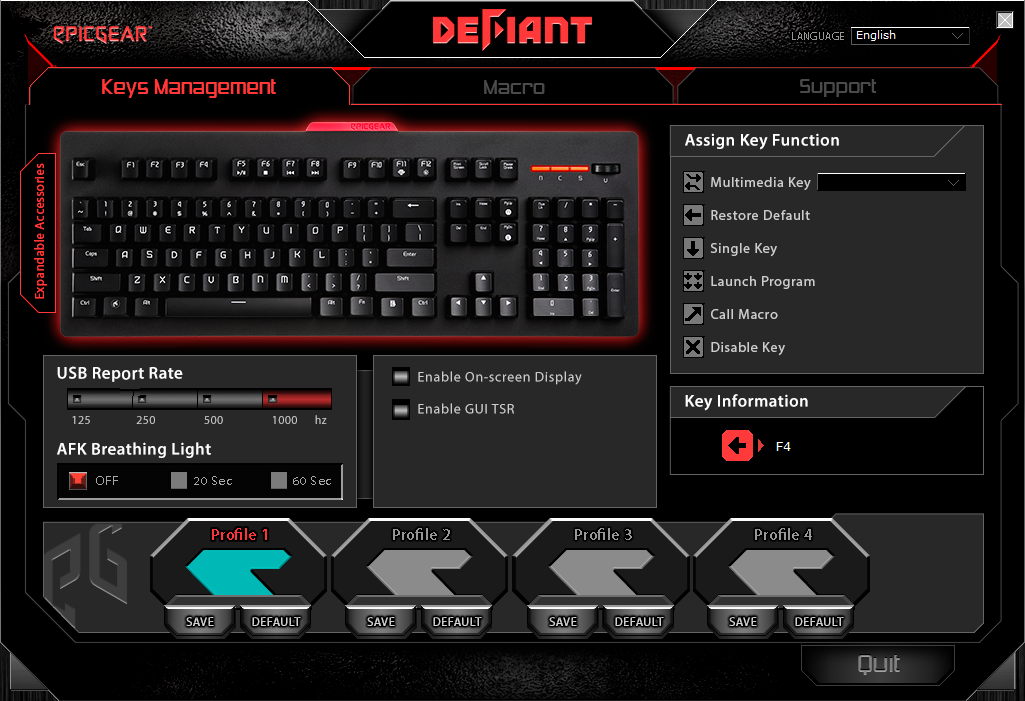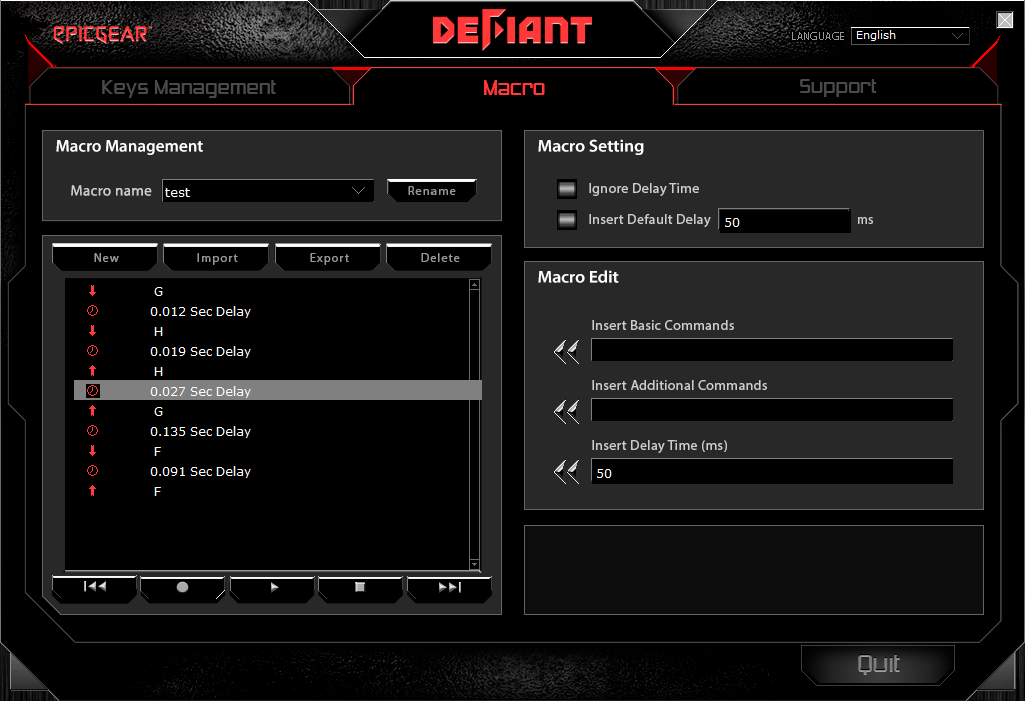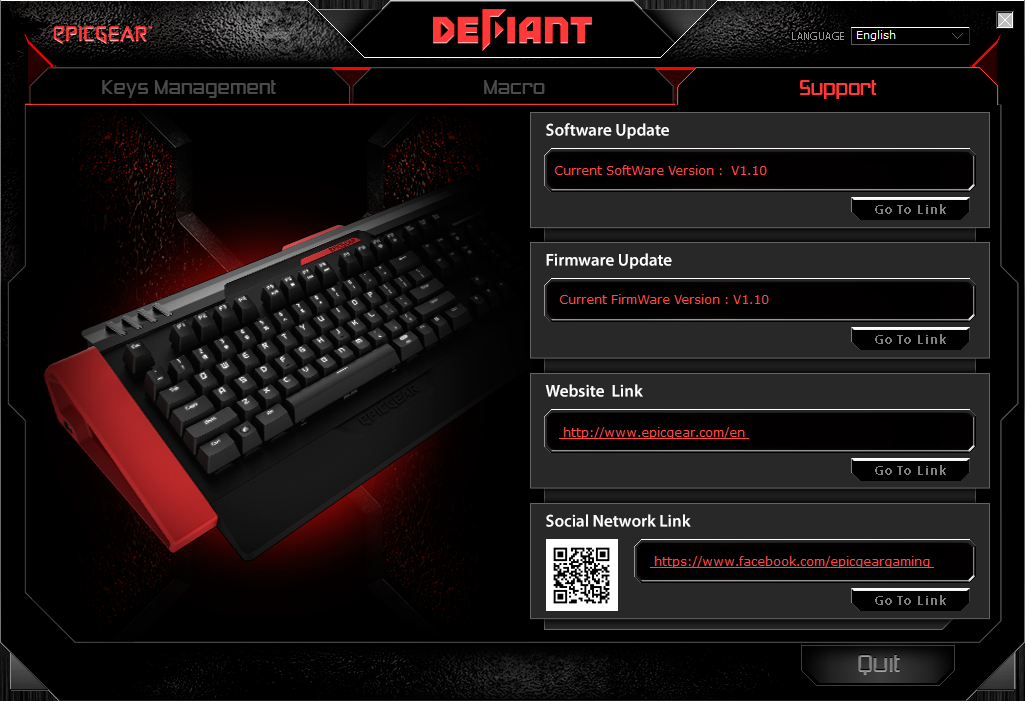The EpicGear Defiant Mechanical Gaming Keyboard Review
by E. Fylladitakis on May 11, 2016 9:00 AM ESTQuality Testing
In order to test the quality and consistency of a keyboard, we are using a texture analyser that is programmed to measure and display the actuation force of the standard keyboard keys. By measuring the actuation force of every key, the quality and consistency of the keyboard can be quantified. It can also reveal design issues, such as the larger keys being far softer to press than the main keys of the keyboard. The actuation force is measured in Centinewton (cN). Some companies use another figure, gram-force (gf). The conversion formula is 1 cN = 1.02 gf (i.e. they are about the same). A high quality keyboard should be as consistent as possible, with an average actuation force as near to the manufacturer's specs as possible and a disparity of less than ±10%. Greater differences are likely to be perceptible by users. It is worth noting that there is typically variance among keyboards, although most keyboard companies will try and maintain consistency - as with other reviews, we're testing our sample only.
The machine we use for our testing is accurate enough to provide readings with a resolution of 0.1 cN. For wider keys (e.g. Enter, Space Bar, etc.), the measurement is taking place at the center of the key, right above the switch. Note that large keys generally have a lower actuation force even if the actuation point is at the dead center of the key. This is natural, as the size and weight of the keycap reduces the required actuation force. For this reason, we do display the force required to actuate every key but we only use the results of the typical sized keys for our consistency calculations. Still, very low figures on medium sized keys, such as the Shift and Enter keys reveal design issues and can easily be perceptible by the user.
We tested the EpicGear Defiant with its stock EG Purple switches. The performance of EpicGear’s switches looks close to Kailh’s, but there is a significant difference - the variation is not evenly distributed. EpicGear’s Purple switches tend to have a lower actuation force than the rated 50 cN, which can be seen by the average of 47.9 cN that we had over the main keys. The disparity away from this average is high, reaching ±9.97%. Due to the high disparity and the low average, we have keys with readings over 10% lower than the manufacturer’s 50 cN specification. The difference is not dramatic and it is unlikely that a person can discern it by touch, but we would definitely prefer to see Cherry MX consistency figures for those that demand a finely tuned package.
Software
The software package of the Defiant is relatively simple and easy to use. It is divided into three tabs but most of the options can be found in the first tab, called “Key Management”. From this tab, the user can individually program every key of the keyboard and up to four different keyboard profiles. The keys can be reprogrammed to execute simple keystrokes, multimedia functions, macros or launch external applications.
The ability to launch external applications will be very useful for gamers, as the macro recording capabilities of the software are basic. Macros can be programmed via the second tab of the software, but the software supports only keyboard keystrokes. There are no options to add any kind of mouse movements or clicks. At least the software allows some basic editing of the Macros after they have been created (unlike some other bundled keyboard macro software), but we suspect that the majority of advanced gamers who require complex macros will be forced to use third party software.
The “Support” Tab of the software is the most basic, linking to the company’s website and allowing the user to check for software and firmware updates.














23 Comments
View All Comments
Samus - Wednesday, May 11, 2016 - link
I personally used a few Microsoft Natural 4000's for years, a few because they only last about 9 months before the keys start to bind (especially return and space bar)I found the layout just aggressive enough to be comfortable but not so aggressive that I was unable to go back to using a rectangular ANSI keyboard layout, which is inevitable since I work on multiple computers daily (I'm in IT) or even my own notebook.
Which is the real issue with the uber ergonomic designs. They are awesome once you are used to them, but it's like typing on hot ashes when you have to inevitably used a standard keyboard again at some point.
BrokenCrayons - Thursday, May 12, 2016 - link
The Natural 4000 was one of the models I tried using. I didn't have it long enough to test the longevity before I gave it away, but I older model MS Naturals suffered from the same key binding problems. I had some beige Natural from the early 2000s that I used in place of a Model M for a year or so and it was misery to use before it started to wear out, but after the keys turned crappy, it was a hand destroying monster.Anyway IIRC, I used the 4000 for three-ish months and it was disappointing that it made my wrists and hands feel just as bad, but much of my computing time involves typing because I write extensively so I'm always looking for an alternative design that will spare me the pain. It's important for my work and for my hobby writing books that I can type for hours. For me, the transition back to a flat keyboard was always a huge relief. I can't describe how much better it felt to use a normal keyboard on a laptop or netbook. Yeah, I realize that's an experience unique to me, but I was really disappointed that mechanical keyboards and ergo keyboards always fall short of making things better than a membrane board. At the moment, the least painful keyboard I've used is the one built into my workplace Dell Latitude e6440. Typing on it is fantastic and I've long since unplugged my docking station keyboard.
As for longevity, the only membrane keyboards I've managed to kill off are dead because I spilled tea on them or the MS keyboards that, after hearing about your experience with the 4000, might just have a long-running design problem. And there's an original Model M that I typed to death. My experiences with other cheap $10-20 keyboards and laptop/netbook keyboards is that they've all been pretty much bulletproof for as long as I've needed them.
erple2 - Saturday, May 21, 2016 - link
You can still buy the Model M today (sort of) - Unicomp bought the licensing rights to the buckling spring, and they can now be bought in USB varieties from pckeyboard (http://www.pckeyboard.com/page/category/UltraClass...Impulses - Wednesday, May 11, 2016 - link
They've already tested some ergo options, read thru back reviews.Ogewo - Wednesday, May 11, 2016 - link
Those reviews are few and far between. I'd like them to be numerous and close together.althaz - Thursday, May 12, 2016 - link
Those keyboards are pretty rare though, they are over-represented here, really.ACeeTee - Wednesday, May 11, 2016 - link
Just made an account to point out that this is not the first modular keyboard, Mad Catz has had the S.T.R.I.K.E 7 since 2012 and that is modular :/alexvoda - Wednesday, May 11, 2016 - link
I have not read the article yet, but I already spotted bulshit in the first paragraph.I quote: "which is the first modular and expandable mechanical keyboard"
Starting from the end:
- Yes, it is a keyboard
- Yes, it uses mechanical switches
- Expandable?? Umm, NO! Expandable means 1. to increase in extent, size, volume, scope, etc.; 2. to spread or stretch out; unfold; 3. to express in fuller form or greater detail; develop.
The keyboard on the IBM Thinkpad 701c is the only expandable keyboard I know of. You can see it in action here: https://www.youtube.com/watch?v=SLj3aCfqzOM
- Modular?? Umm, NO! The Azio Levetron Mech4 is modular. The Microsoft Sidewinder x6 is modular. The Tesoro Tizona is modular. The Ultimate Hacking Keyboard is very modular. This one? Not so much.
- First? As in first to use user replacable switches. Nope. AFAIK the Team Wolf Void Ray+ and the Team Wolf Zuque+ were launched before this one. And certainly the "Smart 68" was launched before all three.
hoarangE - Wednesday, May 11, 2016 - link
Personally, I think you are reading far to into that sentence, as it could have easily been a typo and read as "GeIL’s latest gaming keyboard, which is THEIR first modular and expandable mechanical keyboard and comes with EpicGear’s own proprietary switches" which would make your whole statement moot.Plus if you read more of the article, you would have seen that this product IS, in fact, modular (though the modular units were not available for review at this time).
Anyways, to the author, thanks for the article!
fanofanand - Wednesday, May 11, 2016 - link
The Razer Tarantula from circa 2006-2007 also had replaceable keys. Worst keyboard I ever bought.